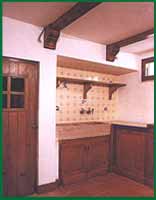| A
leisure area in a country scenery |
|
|||
|
The
two arcs ornamentally enhance the use of the structural beams. They were
covered with tijolo-burro (thick and compact bricks), presenting a closing
stone created on purpose, after being aged. These beams used to be cold
and skeletal. The ceiling and wall were coated with plaster using traditional
lime mortar. But the beams are not just ornamental, as they also hide
the electrical cables that were all replaced.
The
small windows at the level of the outside pavement remained as they were
but two others were enlarged on the concrete wall, a little bit further,
so the wine cellar would have more light. A typical Alentejo chimney was
recreated with its small fire corner, and true old flagstone floor in
the inside. The hand painted azulejos have the old shape 14x14 and although
recent they were handmade. |

|
||||||||||||||||||||||||||||||||||||||||||||||||
| "Arquitectura
& ConstruÁ„o" Magazine Photographer Josť Miguel Figueiredo |
© 2002 - 2025 Paulo
Jones
|